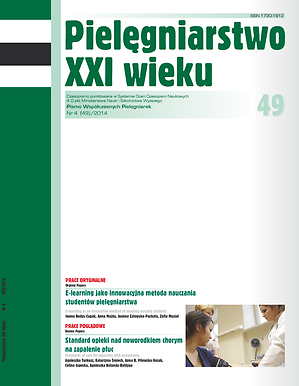Analiza całkowitego czasu interwencji Zespołów Ratownictwa Medycznego na przykładzie wybranych podstacji Wojewódzkiego Pogotowia
Słowa kluczowe:
medycyna ratunkowa, zespół ratownictwa medycznego, opieka przedszpitalna, całkowity czas interwencji na poziomie przedszpitalnym, złota godzinaAbstrakt
Wstęp. Czas interwencji Zespołów Ratownictwa Medycznego (ZRM) na poziomie przedszpitalnym jest ważnym czynnikiem wpływającym na rokowanie oraz satysfakcję pacjenta.
Cel pracy. Określenie całkowitego czasu interwencji ZRM na poziomie przedszpitalnym.
Materiał i metody. Analizą objęto łącznie 1197 wyjazdów ZRM. Uwzględnione zostały dane podstacji Śródmieście, położonej w centrum Lublina, oraz podstacji Garbów, zlokalizowanej we wsi gminnej. Do badań włączono dokumentację dotyczącą wyjazdów mających miejsce każdego pierwszego tygodnia kwartału 2009 roku.
Wyniki. Średni czas interwencji ZRM na poziomie przedszpitalnym był równy 35,4 ± 12,7 minuty, minimalny czas wyniósł 5 minut, maksymalny – 121 minut, dolny kwartyl – 27 minut, górny kwartyl – 42 minuty. Mediana czasu od przyjęcia zgłoszenia przez dyspozytora do przekazania pacjenta w SOR wyniosła 34 minuty. Całkowity czas interwencji ZRM na poziomie przedszpitalnym był krótszy w mieście niż na terenach wiejskich – mediana odpowiednio 33 min i 46 min oraz w podstacji Śródmieście w porównaniu do podstacji Garbów – mediana odpowiednio 34 min i 49 min. Na upływający czas istotny wpływ ma tryb wyjazdu: mediana całkowitego czasu interwencji ZRM na poziomie przedszpitalnym podczas wyjazdów w trybie zwykłym, pilnym i alarmowym wynosi odpowiednio 36 min, 31 min i 31 min.
Wnioski. Średni całkowity czas interwencji na poziomie przedszpitalnym był równy 35,4 ± 12,7 minuty, a mediana wyniosła 34 minuty. Na całkowity czas interwencji na poziomie przedszpitalnym istotny statystycznie wpływ ma lokalizacja miejsca zdarzenia, podstacja oraz tryb wyjazdu
Bibliografia
1. Jakubaszko J. Założenia organizacyjne systemu zintegrowanego ratownictwa medycznego. W: Jakubaszko J (red.) Ratownik medyczny. Wrocław: Górnicki Wydawnictwo Medyczne. 2003: 1-3.
2. Cowley RA. The resuscitation and stabilization of major multiple trauma patients in a trauma center environment. Clin Med. 1976; 83:16-22.
3. Brongel L. Ogólne zasady działania sieci Zintegrowanego Ratownictwa Medycznego. W: Brongel L (red.). Złota godzina. Czas życia, czas śmierci. Kraków: Wydawnictwo Medyczne. 2007:11-23.
4. Rasmus A, Aleksandrowicz – Krawiec R, Krawiec K. „Złota godzina”. Med Intens Rat. 2005,8(3):161-165.
5. Rasmus A, Rokosz A, Olczyk W, i wsp. „Łańcuch ratunkowy” – kluczowa koncepcja w medycynie ratunkowej. Med Intens Rat. 2005,4:195-199.
6. Florek M. Jakość pomocy doraźnej i leczenia szpitalnego w ocenie osób poszkodowanych w wypadkach. Zdr Publ. 2005;115(3):303-306.
7. Báez AA, Lane PL, Sorondo B, et al. Predictive effect of out-of-hospital time in outcomes of severely injured young adult and elderly patients. Prehosp Disaster Med. 2006;21(6):427-30.
8. Tien HC, Jung V, Pinto R, et al. Reducing time-to-treatment decreases mortality of trauma patients with acute subdural hematoma. Ann Surg. 2011;253(6):1178-83.
9. Kidher E, Krasopoulos G, Coats T, et al. The effect of prehospital time related variables on mortality following severe thoracic trauma. Injury. 2012;43(9):1386-92.
10. Rozporządzenie Ministra Zdrowia z dnia 7 maja 2007 r. w sprawie ramowych procedur przyjmowania wezwań przez dyspozytora medycznego, i dysponowania zespołami ratownictwa medycznego. Za: file:///C:/Users/AA/Downloads/D20070605.pdf (dostęp dn. 27. 03.2014)
11. Guła P. Obsługa zgłoszeń alarmowych, W: Powiadamianie i dysponowanie w ratownictwie medycznym. Kraków: Wydawnictwo Medycyna Praktyczna. 2009; 43-58.
12. Rozporządzenie Ministra Zdrowia z dnia 10 stycznia 2014 r. w sprawie ramowych procedur przyjmowania wezwań przez dyspozytora medycznego i dysponowania zespołami ratownictwa medycznego. Za: http://www2.mz.gov.pl/wwwfiles/ma_struktura/docs/rozp_proceprzywezw_10012014.pdf (dostęp dn. 28. 03.2014)
13. Hupert Z, Horoch A, Jarosz J. Dokumentacja wyjazdowa pogotowia ratunkowego – Karta Zlecenia Wyjazdu. Zdr Publ. 2001;111(4):282-285.
14. Newgard CD, Schmicker RH, Hedges JR, et al. Resuscitation Outcomes Consortium Investigators: Emergency medical services intervals and survival in trauma: assessment of the “golden hour” in a North American prospective cohort. Ann Emerg Med. 2010;55(3):235-246.
15. Lerner EB, Billittier AJ, Dorn JM, et al. Is total out-of-hospital time a significant predictor of trauma patient mortality? Acad Emerg Med. 2003;10(9):949-54.
16. Liberman M, Roudsari BS. Prehospital trauma care: what do we really know? Curr Opin Crit Care. 2007;13(6):691-6.
17. Bigdeli M, Khorasani-Zavareh D, Mohammadi R. Pre-hospital care time intervals among victims of road traffic injuries in Iran. A cross-sectional study. BMC Public Health. 2010;10: 406.
18. Ustawa z dnia 8 września 2006 r. o Państwowym Ratownictwie Medycznym. Dz. U. 2006 r. nr 191, poz. 1410.
19. Kośla P. Inny świat, czyli ratownictwo medyczne poza miastem. Na Ratunek. 2010;3:14–18.
20. Guła P. Ratownictwo medyczne, podstawy organizacji i systemu, W: Powiadamianie i dysponowanie w ratownictwie medycznym, Guła P. Kraków: Wydawnictwo Medycyna Praktyczna. 2009: 11-42.
21. Czerniewski A, Basiński A, Jaśkiewicz J. Ocena skuteczności resuscytacji krążeniowo – oddechowej na podstawie działalności Działu Ratownictwa Medycznego w Elblągu. Med Intens Rat. 2004,7(4):195-199.
22. Kózka M, Kawalec E, Płaszewska-Żywko L. Analiza interwencji zespołów karetki pogotowia ratunkowego. Zdr Publ. 2008;118(1):54-58.
23. Mroczkowska M, Niedźwiedzki K, Gaszyński W. Czas dotarcia zespołów ratownictwa medycznego do pacjenta z nagłym zatrzymaniem krążenia w świetle znowelizowanej Ustawy o Państwowym Ratownictwie Medycznym. Med Intens Rat. 2007;10 (2):73-79.
24. Sukumaran S, Henry JM, Beard D, et al. O’Donnell JJ, Gray, AJ. Prehospital trauma management: a national study of paramedic activities. Emerg Med J. 2005; 22 (1): 60-63.
25. Aftyka A, Rudnicka-Drożak E, Rybojad B. A comparison of ambulance responses to incidents of Medical Emergency Squads led by nurses and paramedics – a retrospective single-center study. Int J Nurs Stud. 2014; (51): 555-561.
Pobrania
Opublikowane
Numer
Dział
Licencja
Prawa autorskie (c) 2014 Autorzy

Utwór dostępny jest na licencji Creative Commons Uznanie autorstwa 4.0 Międzynarodowe.




